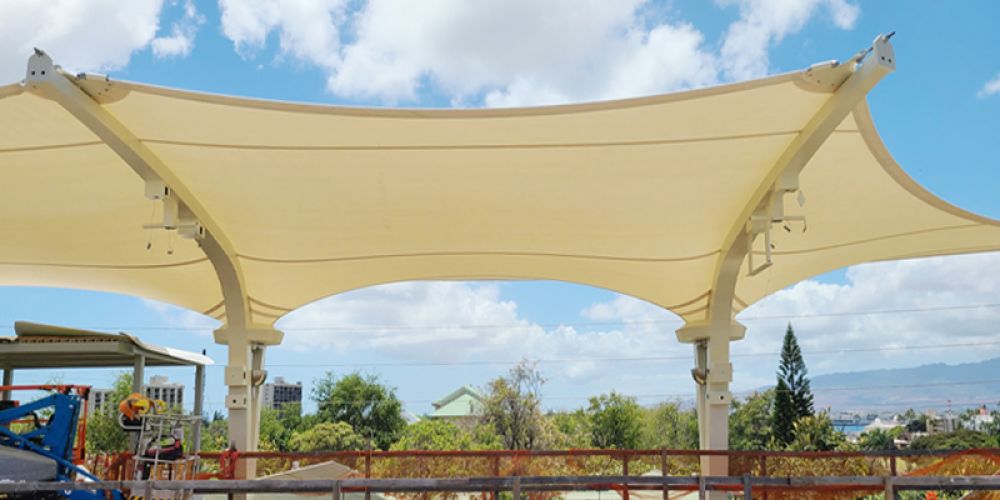
The heat-sealing splicing of the membrane material of the tensioned membrane structure is to heat the membrane material edge with a heat-sealing machine to melt the polymer material, and then apply pressure to achieve a firm connection. The specific methods and key points are as follows:
1. Heat-sealing splicing method
High-frequency welding
Principle: Use a high-frequency electric field to make the polar molecules inside the membrane material vibrate at a high frequency, generate heat to melt the membrane material.
Applicability: Suitable for heat-weldable membrane materials such as PVC, with fast splicing speed and high precision, and often used in landscape membrane structures with complex shapes.
Equipment requirements: High-frequency welding equipment is required.
Hot plate fusion
Principle: A hot plate is sandwiched between two membrane materials, and the hot plate is melted to fuse the membrane materials.
Applicability: Applicable to membrane materials such as PTFE and ETFE, with a fusion width of more than 75mm, and it is necessary to ensure that there are no wrinkles or peeling.
Hot air fusion
Principle: Use hot air to melt the edge of the membrane material, and then apply pressure to fit.
Applicability: With a combined width of more than 40mm, it is often used for local repair of PVC membrane materials.
2. Heat-sealing process
Material preparation
Ensure that the edge of the membrane is flat and free of pollution, and clean it if necessary.
Select appropriate heat-sealing parameters (temperature, pressure, time) according to the type of membrane.
Heat-sealing operation
Align the edges of the membrane and place them in the heat-sealing machine, and start the equipment for heating and melting.
After reaching the set temperature, apply pressure to make the membrane fit tightly, and keep it for a certain time until it cools and solidifies.
Quality inspection
Check whether the splicing is flat, free of bubbles, and free of damage, and the strength is not lower than that of the parent material.
Seal the splicing parts to prevent rainwater from penetrating.
3. Advantages and disadvantages of heat-sealing splicing
Advantages
High connection strength, good sealing, and excellent waterproof performance.
The appearance of the splicing is flat and beautiful, suitable for permanent buildings.
Disadvantages
The equipment cost is high and the technical requirements for operators are strict.
The heat-sealing parameters of different membranes vary greatly and need to be debugged in a targeted manner.
IV. Application Cases
Large-scale sports stadiums: For example, the Beijing "Water Cube" uses ETFE membrane materials for heat-sealing and splicing to achieve a large-span column-free space.
Landscape membrane structure: For example, the sunshade in the city park uses high-frequency welding to achieve complex curved surface shapes, taking into account both beauty and practicality.
V. Precautions
Material matching: Different membrane materials need to adopt corresponding heat-sealing methods to avoid splicing failure caused by mismatch of material properties.
Temperature control: Overheating can easily lead to carbonization of membrane materials, and overcooling cannot effectively melt, so the heat-sealing temperature needs to be precisely controlled.
Uniform pressure: When applying pressure, it is necessary to ensure that the membrane material is evenly stressed to avoid local deformation or damage.
By scientifically selecting heat-sealing methods and strictly controlling process parameters, the heat-sealing and splicing of membrane materials in tensile membrane structures can achieve efficient and reliable connections, providing a stable and beautiful covering system for buildings.